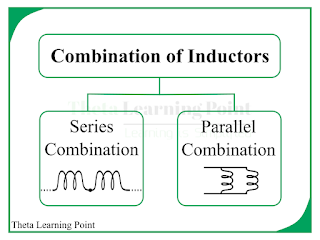An Inductor
is a passive circuit element that opposes any change in the magnitude of the
current through it. A typical inductor is made by twisting a wire of finite
length into a coil. Inductor has the ability to store electrical energy in the
magnetic field and can supply this stored energy back into the circuit at a
later point in time.
In practice, several inductors are
connected either in series or parallel to obtain a desired value of inductance.
Thus, we will discuss the series combination of inductors and the parallel
combination of inductors one by one.
Series Combination of Inductors
A combination of inductors in which
inductors are connected end-to-end so that there is only one path for electric
current to flow is called a series
combination of inductors.
Consider a series combination of two
inductors as shown in figure-1. Here, the current flowing through both
inductors is the same.
`\v=v_1+v_2" "…(1)`
But, the voltage across an inductor is
given by,
`\v_L=L (di)/dt`
Therefore, equation (1) can also be
written as,
`\v=L_1 (di)/dt+L_2 (di)/dt`
`\⟹v=(L_1+L_2 ) (di)/dt" "…(2)`
Since, v is the total voltage across the combination, and is given by,
`\v=L_(eq) (di)/dt" "…(3)`
Where, Leq is the equivalent inductance of the series combination
of inductors. Thus, from eqns. (2) & (3), we have,
`\L_(eq) (di)/dt=(L_1+L_2 ) (di)/dt`
`\∴L_(eq)=L_1+L_2" "…(4)`
If there are N inductors connected in series, then
`\L_(eq)=L_1+L_2+L_3+⋯+L_N" "…(5)`
Thus, from equations (4) & (5), it is
clear that the equivalent inductance of series
connected inductors is the sum of individual inductances.
Parallel Combination of Inductors
When one end of each inductor is joined
to a common point and the other end of each inductor is joined to another
common point so that there are as many paths for current flow as the number of
inductors, it is called the parallel
combination of inductors.
`\i=i_1+i_2" "…(6)`
But, the current through an inductor is
given by,
`\i_L=1/L ∫_0^t vdt`
Assuming the initial condition to be
zero. Therefore, equation (6) may also be written as,
`\i=1/L_1 ∫_0^t vdt+1/L_2 ∫_0^t vdt" "…(7)`
Also, i
is the total circuit current, which is given by,
`\i=1/L_(eq) ∫_0^t vdt" "…(8)`
Where, Leq is the equivalent inductance of the parallel
combination.
Thus, from eqns. (7) & (8), we get,
`\1/L_(eq) ∫_0^t vdt=(1/L_1 +1/L_2 ) ∫_0^t vdt`
`\∴1/L_(eq) =1/L_1 +1/L_2" "…(9)`
If there are N inductors connected in the parallel combination, then
`\1/L_(eq) =1/L_1 +1/L_2 +⋯+1/L_N" "…(10)`
Thus, according to equations (9) &
(10), the equivalent inductance of a
parallel combination of inductors is the reciprocal of the sum of the
reciprocals of inductances of the individual inductors.
For two inductors connected in parallel, equation
(9) becomes,
`\1/L_(eq) =(L_2+L_1)/(L_1 L_2 )`
`\∴L_(eq)=(L_1 L_2)/(L_1+L_2 )" "…(11)`
Hence, when two inductors are combined in parallel, then their equivalent
inductance is equal to the product divided by the sum of the inductances of the
two inductors.
Important Points about Inductors
The
following are the important points about the series combination of inductors-
- The current in each inductor is the same.
- The total inductance of the combination is equal to the sum of individual inductances.
- The voltage across each inductor is different, and it depends upon its inductance value.
- The total inductance of the combination is greater than the largest of the inductances.
The
following are the important points about the parallel combination of inductors-
- The voltage across each inductor is the same in the parallel combination.
- As the number of inductors in the combination is increased, the total inductance of the combination is decreased.
- The total inductance of the combination is less than the smallest of the inductances.
Numerical
Examples – Find the equivalent inductance of the
circuit shown in figure-3 looking from terminals ab.
`\L_1=20+12+10=42" H"`
The series combination of 20 H, 12 H, and
10 H is connected in parallel with the inductor of 7 H, then
`\L_2=(42×7)/(42+7)=6" H"`
Finally, this combined 6 H, 4 H, and 8 H
are connected in series, thus, the equivalent inductance of the circuit is
`\L_(eq)=6+4+8=18" H"`
Conclusion
Thus, in this article, we discussed
series and parallel combinations of inductors. We derived the expression for
their equivalent inductance and solved a numerical example for a better
understanding of the concept.





.png)





0 Comments